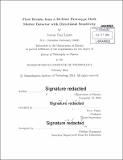First results from a 20-liter prototype dark matter detector with directional sensitivity
Author(s)
Lopez, Jeremy Paul
DownloadFull printable version (26.39Mb)
Alternative title
First results from a twenty-liter prototype dark matter detector with directional sensitivity
Other Contributors
Massachusetts Institute of Technology. Department of Physics.
Advisor
Peter Fisher.
Terms of use
Metadata
Show full item recordAbstract
Astronomical and cosmological evidence suggests that 27% of the energy content of the universe is in the form of non-baryonic matter referred to as "dark matter." Weakly interacting massive particles have long been considered attractive candidates for this dark matter and can be found in a wide variety of models of physics beyond the Standard Model. The Dark Matter Time Projection Chamber experiment uses low-pressure gas time projection chambers to search for nuclear recoils caused by interactions between nuclei inside a detector and weakly interacting massive particles in the dark matter halo of the Milky Way galaxy. These detectors are also able to reconstruct the directions of these nuclear recoils, allowing for better rejection of possible background events. This thesis describes the design of a small prototype detector and the strategies used by the DMTPC collaboration to reconstruct events, reject backgrounds, and identify nuclear recoil candidate events. It presents the results of several studies aimed at understanding background events in DMTPC detectors. Finally, this work will present the first results from a nuclear recoil search taken with this detector in a surface laboratory at MIT.
Description
Thesis: Ph. D., Massachusetts Institute of Technology, Department of Physics, 2014. 133 Cataloged from PDF version of thesis. Includes bibliographical references (pages 191-199).
Date issued
2014Department
Massachusetts Institute of Technology. Department of PhysicsPublisher
Massachusetts Institute of Technology
Keywords
Physics.